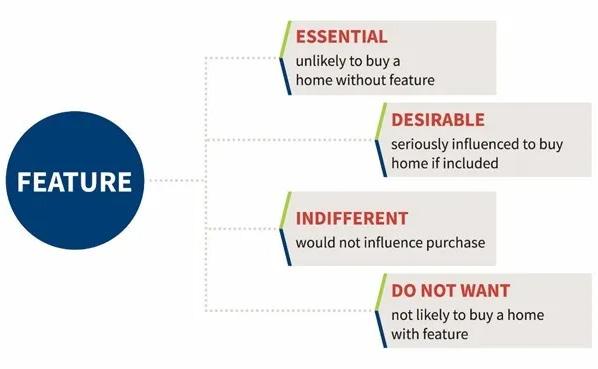
3 minute read
Eye on Housing: In the Bath, First Time Buyers Really Want BOTH a Shower & Tub
IN THE BATH, FIRST-TIME BUYERS REALLY WANT Both a Shower & Tub
Among first-time buyers, both a shower stall and tub in the primary bath ranked as the most popular of the 18 bathroom features listed in the NAHB study, What Home Buyers Really Want, 2021 Edition. The study asked first-time, as well as repeat, home buyers to rate the kitchen features on the following, four-tier scale (which emphasizes how a feature influences the buyer’s purchase decision):
The graph below shows how first-time buyers rated the bathroom features, sorted in descending order of percentage rating the features essential or desirable. Last Friday’s post included a similar chart for kitchen features. A slightly earlier post discussed the most popular of all 200-plus home and community features covered in the study among first-time buyers.
At the top of the bathroom graph, 72 percent of first-time buyers rated both a shower stall and tub in the primary bath essential or desirable, followed closely by a linen closet, rated essential or desirable by 70 percent. These also ranked as the two most popular bathroom features among repeat buyers, but in reverse order (with 77 percent of repeat buyers rating the linen closet essential or desirable, compared to 72 percent for the shower stall-tub combination).:
BY: PAUL EMRATH
At the top of the bathroom graph, 72 percent of first-time buyers rated both a shower stall and tub in the primary bath essential or desirable, followed closely by a linen closet, rated essential or desirable by 70 percent. After the top two, 67 percent of first-time buyers rated a private toilet compartment essential or desirable, followed by 65 percent for a whirlpool tub. Next comes a group of bathroom features rated essential or desirable by 62 percent of first-time buyers: a double vanity, multiple shower heads, a granite vanity and body spray panels.
The list of the most popular bathroom features is generally similar for both first-time and repeat buyers. To the extent there are differences, they show up at the low end of the scale, among the relatively less popular kitchen features. Although 27 percent of both first-time and repeat buyers say they “Do Not Want” to have only a shower stall in the primary bath (i.e., are unlikely to buy a home that doesn’t also have a tub), repeat home buyers are considerably more likely to say they “Do Not Want” the other features at the bottom of the chart.
For example,
37 percent of repeat buyers “Do Not Want” a bidet (compared to 27 percent of first-time buyers), 42 percent of repeat buyers “Do Not Want” dual toilets in the primary bath (compared to 29 percent of firsttime buyers), 34 percent of repeat buyers “Do Not Want” His & Hers baths (compared to 22 percent of first-time buyers), 22 percent of repeat buyers “Do Not Want” color (as opposed to white) toilet, tubs & sinks (compared to 12 percent of first-time buyers); and 29 percent of repeat buyers “Do Not Want” a skylight in the primary bath (compared to 17 percent of firsttime buyers). To see home buyer preferences for other features (including all results broken down by Census division, age, generation, race/ethnicity, income, priced expected to pay for the home, household composition, and firsttime vs. repeat buyer) and a complete description of the survey design and sampling methodology, please consult the full study.

RESIDENTIAL BUILDING WORKER
Wages Continue To Rise
BY: JING FU
Compared to a year ago, average hourly earnings for residential building workers continue to rise, as the construction labor market remains tight.
According to the Bureau of Labor Statistics (BLS) report, average hourly earnings (AHE) for residential building workers were $28.66 in February 2022, increasing 6% from $27.01 a year ago. This was 16.7% higher than the manufacturing’s average hourly earnings of $24.56, 12.9% higher than transportation and warehousing’s, and 10.8% lower than mining and logging’s. In February, the job openings rate in construction remained elevated at 4.8% and the unemployment rate fell to 3.6% in March. As skilled labor shortage persists, rising wages may be one of the effective ways to attract employees to fill empty positions.
Average hourly earnings for residential building workers have increased significantly since the COVID-19 pandemic recession. Between December 2019 and December 2021, residential building workers’ average hourly earnings increased about 12%.
Note: Data used in this blog relate to production and nonsupervisory workers in the residential building industry. This group accounts for approximately two-third of the total employment on residential building industry.











